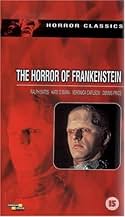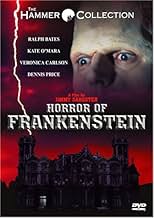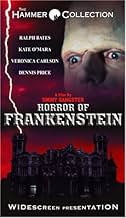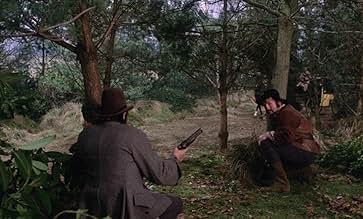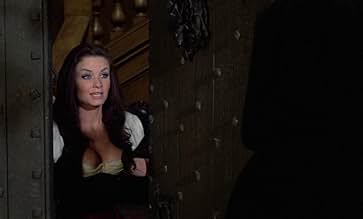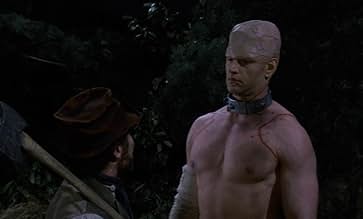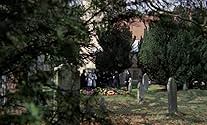PUNTUACIÓN EN IMDb
5,8/10
3 mil
TU PUNTUACIÓN
Victor Frankenstein construye un hombre a partir de partes del cuerpo de repuesto; el monstruo cobra vida y causa estragos.Victor Frankenstein construye un hombre a partir de partes del cuerpo de repuesto; el monstruo cobra vida y causa estragos.Victor Frankenstein construye un hombre a partir de partes del cuerpo de repuesto; el monstruo cobra vida y causa estragos.
David Prowse
- The Monster
- (as Dave Prowse)
Chris Lethbridge-Baker
- Priest
- (as C. Lethbridge Baker)
Argumento
¿Sabías que...?
- CuriosidadesWriter / producer / director Jimmy Sangster was brought in to look at and revise, if necessary, the original screenplay by Jeremy Burnham, and realized that it was essentially La maldición de Frankenstein (1957) all over again, which had been done just a dozen years earlier. Not wanting to do the same movie again, it was his decision to inject all the humor and sex into the script. He didn't commit fully to the project until Hammer Studios agreed to give him the opportunity to direct.
- PifiasWhen Victor circles the number 4 on the chart, the number 19 can be seen on the lower torso. When the camera pulls back, a large paper is covering the private parts of the diagram, obscuring the number 19.
- Citas
Victor Frankenstein: [drunk] I'm going to make a people-- person!
- ConexionesEdited into I Am Your Father (2015)
Reseña destacada
This was top Hammer screenwriter Jimmy Sangster's first directorial effort for the company (incidentally, I watched the other two - LUST FOR A VAMPIRE [1971] and FEAR IN THE NIGHT [1972] - in quick succession). I hadn't picked this up on DVD earlier because of its much-maligned reputation: however, I was extremely surprised to find it quite effective!
Given that it's basically a remake of THE CURSE OF FRANKENSTEIN (1957), Sangster took a radically different approach - treating the events as black comedy; the resulting film is very funny indeed at times (though it almost feels like "Carry On Frankenstein": witness the disembodied hand coming to life to give the two-finger gesture and Ralph Bates' comments at Kate O'Mara's cleavage!). The film features an abrupt, doubly ironic ending - while, as opposed to STRAIGHT ON TILL MORNING (1972), there's plenty of gore here but no nudity. Still, despite being made on the cheap, it all looks pretty decent (a virtue common to most Hammer product, in fact).
Bates (who showed real promise but, essentially, came to Hammer too late) and Dennis Price (as a cheerful body snatcher who likes to have his pregnant wife do the dirty work for him!) are very good; from the rest of the cast - which includes Jon Finch as a dogged police lieutenant who happens to be a former colleague of Frankenstein's - O'Mara as Bates' sexy but conniving housekeeper/lover comes off best (though Veronica Carlson, who's somewhat underused here, also proves undeniable eye-candy).
There are faults, however: Bates's scientist is, ultimately, too glum in comparison to Cushing's animated characterization; the monster itself is an unfortunate creation (pun intended) - Dave Prowse's physique is certainly ideal for the role (in fact, he returned for FRANKENSTEIN AND THE MONSTER FROM HELL [1974] and proved far more successful at it) but, as depicted here, it comes across as a mere killing machine, showing no emotion or curiosity at its surroundings (such as when the monster kills the O'Mara character or when it ventures outside into the countryside).
Essentially, then, the film emerges as an interesting but not entirely successful reinvention of the Frankenstein saga and, actually, a curious attempt on Hammer's part at this particular stage - given that it followed closely on the heels of one of their finest (and bleakest) efforts! That said, having now watched Hammer's entire Frankenstein series, I can safely say that it's superior overall to their Dracula films.
The extras include a 14-minute career overview by Hammer starlet/beauty Carlson - she feels lucky and privileged to have worked three times for the studio and in the company of such talented people as Freddie Francis, Christopher Lee, Terence Fisher, Peter Cushing, Jimmy Sangster and Ralph Bates. Sangster describes in the Audio Commentary how, when he started as a screenwriter, he was careful not to overstep the limitations set by the budget - which he learned from having been a Production Manager for Hammer for the previous several years; as a director, then, he often consulted with his editor to determine whether the latter got all the necessary coverage for any particular scene. He also discusses the rest of his career, going into some detail on the making of such films as TASTE OF FEAR (1961) and THE ANNIVERSARY (1968), and seems baffled - but, at the same time, amused - by the critical about-turn Hammer's output has enjoyed in recent years. With respect to THE HORROR OF FRANKENSTEIN itself, he admits that he was initially averse to the idea of Ralph Bates as Baron Frankenstein - but, eventually, the two became very good friends and, in fact, Bates appeared in all three films Sangster directed! By the way, Travis Crawford's interesting liner notes compare the film's self-mocking attitude to the even more radical 'revisionist' approach to the Mary Shelley tale seen in FLESH FOR FRANKENSTEIN (1973).
Given that it's basically a remake of THE CURSE OF FRANKENSTEIN (1957), Sangster took a radically different approach - treating the events as black comedy; the resulting film is very funny indeed at times (though it almost feels like "Carry On Frankenstein": witness the disembodied hand coming to life to give the two-finger gesture and Ralph Bates' comments at Kate O'Mara's cleavage!). The film features an abrupt, doubly ironic ending - while, as opposed to STRAIGHT ON TILL MORNING (1972), there's plenty of gore here but no nudity. Still, despite being made on the cheap, it all looks pretty decent (a virtue common to most Hammer product, in fact).
Bates (who showed real promise but, essentially, came to Hammer too late) and Dennis Price (as a cheerful body snatcher who likes to have his pregnant wife do the dirty work for him!) are very good; from the rest of the cast - which includes Jon Finch as a dogged police lieutenant who happens to be a former colleague of Frankenstein's - O'Mara as Bates' sexy but conniving housekeeper/lover comes off best (though Veronica Carlson, who's somewhat underused here, also proves undeniable eye-candy).
There are faults, however: Bates's scientist is, ultimately, too glum in comparison to Cushing's animated characterization; the monster itself is an unfortunate creation (pun intended) - Dave Prowse's physique is certainly ideal for the role (in fact, he returned for FRANKENSTEIN AND THE MONSTER FROM HELL [1974] and proved far more successful at it) but, as depicted here, it comes across as a mere killing machine, showing no emotion or curiosity at its surroundings (such as when the monster kills the O'Mara character or when it ventures outside into the countryside).
Essentially, then, the film emerges as an interesting but not entirely successful reinvention of the Frankenstein saga and, actually, a curious attempt on Hammer's part at this particular stage - given that it followed closely on the heels of one of their finest (and bleakest) efforts! That said, having now watched Hammer's entire Frankenstein series, I can safely say that it's superior overall to their Dracula films.
The extras include a 14-minute career overview by Hammer starlet/beauty Carlson - she feels lucky and privileged to have worked three times for the studio and in the company of such talented people as Freddie Francis, Christopher Lee, Terence Fisher, Peter Cushing, Jimmy Sangster and Ralph Bates. Sangster describes in the Audio Commentary how, when he started as a screenwriter, he was careful not to overstep the limitations set by the budget - which he learned from having been a Production Manager for Hammer for the previous several years; as a director, then, he often consulted with his editor to determine whether the latter got all the necessary coverage for any particular scene. He also discusses the rest of his career, going into some detail on the making of such films as TASTE OF FEAR (1961) and THE ANNIVERSARY (1968), and seems baffled - but, at the same time, amused - by the critical about-turn Hammer's output has enjoyed in recent years. With respect to THE HORROR OF FRANKENSTEIN itself, he admits that he was initially averse to the idea of Ralph Bates as Baron Frankenstein - but, eventually, the two became very good friends and, in fact, Bates appeared in all three films Sangster directed! By the way, Travis Crawford's interesting liner notes compare the film's self-mocking attitude to the even more radical 'revisionist' approach to the Mary Shelley tale seen in FLESH FOR FRANKENSTEIN (1973).
- Bunuel1976
- 18 may 2007
- Enlace permanente
Selecciones populares
Inicia sesión para calificar y añadir a tu lista para recibir recomendaciones personalizadas
- How long is The Horror of Frankenstein?Con tecnología de Alexa
Detalles
- Fecha de lanzamiento
- País de origen
- Sitio oficial
- Idioma
- Títulos en diferentes países
- Horror of Frankenstein
- Localizaciones del rodaje
- St Mary's Church, North Mymms, Hertfordshire, Inglaterra, Reino Unido(Funeral of Professor Heiss)
- Empresas productoras
- Ver más compañías en los créditos en IMDbPro
- Duración1 hora 35 minutos
- Relación de aspecto
- 1.66 : 1(original/negative ratio)
Contribuir a esta página
Sugerir un cambio o añadir el contenido que falta

Principal laguna de datos
By what name was El horror de Frankenstein (1970) officially released in Canada in English?
Responde

